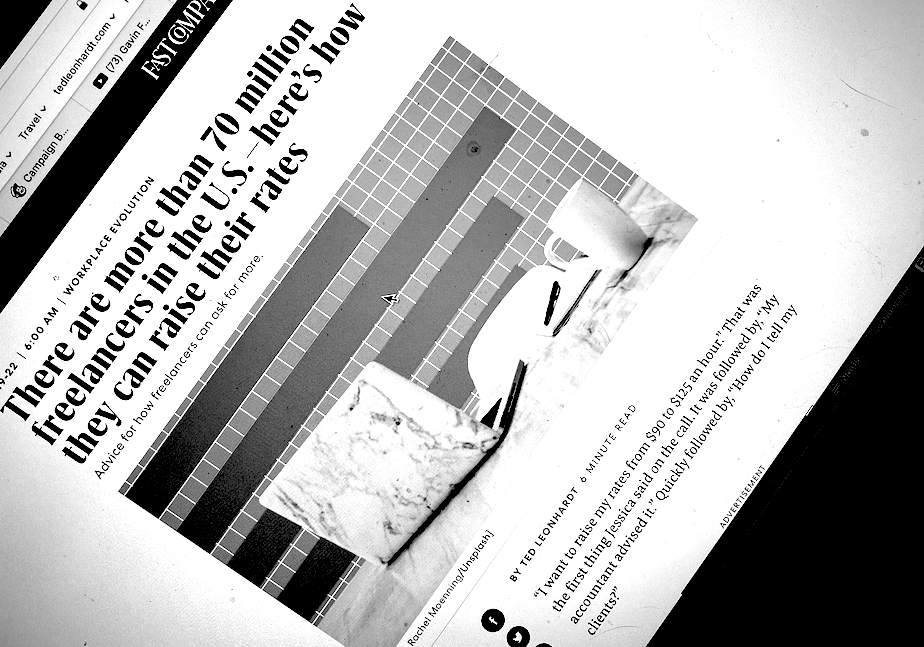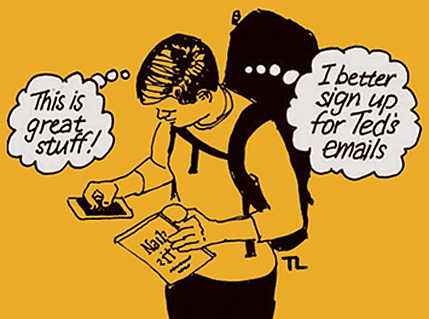There are more than 70 million freelancers in the U.S. –– here’s how they can raise their rates

(published in Fast Company today)
“I want to raise my rates from $90 to $125 an hour.” That was the first thing Jessica said on the call. It was followed by, “My accountant advised it.” Quickly followed by, “How do I tell my clients?”
It’s a question I get asked all the time.
Before I could answer, Jessica continued, “I haven’t raised my rates for at least five years, and my costs have been going up steadily.” I could see she was uncomfortable with her justification. “But,” Jessica went on, “I’m afraid I’ll lose clients if I ask for more.”
I’ve been there. I sympathize. I feel anxious when asking for more money under any circumstances, not just freelancing. But throughout my career, I’ve negotiated design and branding fees in the hundreds and in the millions. Since 2005, I’ve advised creatives on negotiating salaries and fees. I founded and grew The Leonhardt Group, a Seattle brand design firm, and sold it when it reached a staff of 50 and $10 million in sales. After the sale, I took a creative director position in London. In that role, I found that the creatives I worked with across the world had the same struggles asking for the money that I did.
To some, $125 may sound like a lot. To others, it may not sound like much. One online survey pegs average worldwide freelance rates at under $20. But ultimately, the amount isn’t the issue. I remember getting just as nervous raising my rates from $25 to $35 an hour as I did with higher numbers. It’s not the amount; it’s the fear of asking and the possibility that the client will react badly. Or maybe even end the relationship. It underscores that old fear many of us suffer: a fear we’re really not worth it.
The risk of asking for more when we’re feeling vulnerable can cause us to roll over, give in, and ultimately, not earn what we’re worth. But there are more than 70 million freelancers in the United States. I believe they can, and should, raise their rates.
Here is my advice for how freelancers can ask for more:
FIRST, FACE YOUR FEARS
Independent workers are retained hourly, on contracts, and by the project. Some of us are paid in advance of doing the work. The barriers to raising rates in each dynamic may differ, but the emotional barriers are the same. Here’s what I know: In order to ask for more, freelancers need to first face their fears.
Someone once kindly gave me a routine to help me deal with these anxieties, an exercise that I still practice.
Twenty minutes before a stressful meeting, particularly one involving money, I turn off my phone and head to the men’s room. I sit in a stall and, with pen and paper, make a list of my accomplishments. With my list in my pocket, I confidently enter the meeting. I have never recited any of the listed achievements. But simply making the list prepares me to negotiate with confidence. Confidence that, in effect, displaces my self-doubts.
HOW TO RAISE YOUR HOURLY RATES
When freelancers are paid an hourly rate they sometimes lose negotiation power. That is because hourly contracts allow clients to easily compare rates between freelancers and pressure workers to ask for less.
My biggest piece of advice when negotiating for a higher hourly rate: Give your clients plenty of time. Clients don’t like surprises, especially about money. Inform them of the increase a couple of months in advance. And a couple of months also allows you time to drum up new business if a client leaves.
Be prepared to explain why you’re charging more and why it’s in their best interest and yours for them to pay you more. If you’re anything like me, you do your best work when you are happy. Being fairly paid makes most of us feel good about what we’re doing. Making you feel well-paid and secure is in your client’s best interests.
Be sure to highlight how your skills have improved since you began. You are likely faster and more efficient. And perhaps most importantly, you now have a better understanding of your clients and how to meet their needs. And, with inflation, your costs have likely risen. It’s only fair that your hourly rate increases overtime to account for these variables.
Explain your hourly increase directly and in person. Follow up with a text, email, or document, so you have everything in writing. It’s critical that what can be a difficult conversation is done in person or on a video call. You will likely want to be able to respond to your client’s questions or pushback in person to avoidmisunderstandings. And misunderstandings about money have destroyed many client relationships.
HOW TO RAISE YOUR PROJECT RATES
It is often easier to raise your rates when you are billing on a project basis. You simply charge a larger fee the next time you get a project. When working in a fee-for-project arrangement, you are responsible for how much time you put in. The time you put in is a private matter between you and yourself. If a client asks what your hourly rate is, you can say precisely, “it’s a private matter. I’ve found that my clients want to buy completed projects, not hours.”
Clients can benefit from this arrangement, too. With a fixed per-project rate, they know exactly what they’ll pay, so there are no surprises.
One way freelancers can get more out of a fee-for-project arrangement is to bill in advance.
Billing in advance is my favorite way of doing business as a freelancer or a small firm. You are not a bank and are not in the money business. You need the money to support yourself while you’re working. You have rent or a mortgage to pay, healthcare costs, subscriptions, and fees of your own to pay on an ongoing basis. You need cash to cover it all.
When you tell prospective clients that all your work is paid for in advance, it can often separate those who value your work from those who do not. Being paid in advance also removes all the problems of collection and cash flow. Best of all, it sets you apart from your competitors. It shows your confidence while eliminating most of those fears that you might not really be that great.
So if the client asks, “No one else that we’ve talked to expects to be paid in advance, why do you?” Here’s your answer: “I prefer to spend my time working on my client’s behalf, not negotiating fees, not billing, collecting, or being concerned about cash flow.”
In my experience, clients respect freelancers who ask to be paid in advance. And billing in advance is the ultimate leverage for freelancers because it takes away the worry of not being paid.
Here’s my suggestion: If a project you’re asked to do can be completed in a few weeks, ask for it all in advance. And if the project is expected to take several months, ask to be paid each month in advance.
SO, WHAT HAPPENED WITH JESSICA?
Most of Jessica’s clients were contracted with bill-by-the-hour relationships. Most had worked with her for several years.
Out of fear that she couldn’t ask for too much and out of respect for their long working history, Jessica raised her rates by only 10%. She arranged video calls with each client and carefully went through her rationale. To her delight, all of her clients except one felt she deserved a raise.
She lost one client. She was sorry to see them go, but it wasn’t exactly unexpected. The company had been acquired by a large beverage company. Much of the original management team, including her contact, had been let go.
Raising her rates may not have eliminated all of Jessica’s anxieties about asking for more. But going through the experience of negotiating and getting most of what she asked for bolstered her confidence. Jessica saw that her clients respected her not just with their praise for her work but with their money as well.


